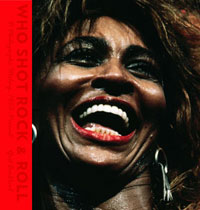Who Shot Rock?

Photography historian and curator Gail Buckland, whose The Magic Image (with Cecil Beaton) is a seminal history of photography and one of her dozen highly regarded books on photography, adds a new volume to her oeuvre, Who Shot Rock and Roll: A Photographic History, 1955 to the Present (Knopf). She explains:
Music has always been the background and front and center was photography—it gave meaning and clarity to my life. As passionate as any rock musician with his or her guitar and record collection, so was I with my Pentax, my Nikon, my enlarger, my prints and photo books. Hearing the soundtracks of my youth connects with my 18-, 22-, 28-year-old self, and I know that rebellious girl with the camera still exists. My rebellion manifested itself in the act of seeing. My goal in writing this book and presenting the extraordinary selection of photographs is to share my passion for photography while holding on to the rock-and-roll spirit.
To paraphrase New Yorker writer Judith Thurman, the history of rock and roll as we think of it is actually the history of rock-and-roll photography. And so to substantiate that claim, Buckland culled 230 pictures from the archives of over 100 photographers, making her choices on the power and strength of the image—occasionally selecting unfamiliar and previously un-anthologized shots. From Elvis to the Beatles, from Jim Hendrix to David Bowie, from Little Richard to Bruce Springsteen, there is a enchanting array of photographs that in sum total represents a very rich and vivid (re)collection of some great musical moments, personalities, and totems.
Though the idea of this book came first, the Brooklyn Museum attached itself to this project. The Worcester Art Museum (Massachusetts), the Memphis Brooks Museum of Art (Tennessee), the Akron Art Museum (Ohio), and a number of other museums have signed on for what is now a traveling exhibition and for which this tome serves as a catalogue.
Gail Buckland observes:
Rock-and-roll photography is varied and elastic. It must be. Sometimes rock and roll is just someone playing a sequence of G,C and D chords; sometimes it is a multi-million dollar stadium spectacular. The selection of photographs in this book mirrors the depth, breadth, and passion of the music, the musicians, and the fans. There is no one soundtrack that is rock, there is no one photographic vision… The unity comes, as Mick Jagger notes, in trying to “keep it real, sincere, and heartfelt, or something.”
